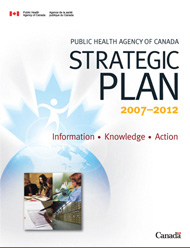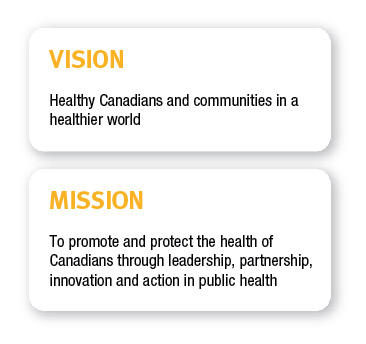Common menu bar links
Institutional links
Diseases & Conditions
Health & Safety
Research & Statistics
Agency Information
Search Box
E-mail this page
Introduction
Vision & Mission | Three Themes
Public health is truly the foundation of a prosperous society. Health and access to a strong and effective health care system continue to be among the highest priorities for Canadians. These priorities are shared by our government, and they continue to be paramount concerns of the Minister of Health.
In September 2004, the Public Health Agency of Canada was created within the federal Health Portfolio to deliver on the Government of Canada's commitment to help protect the health and safety of all Canadians and to increase its focus on public health, and to make a key contribution to improving health and strengthening the health care system. At the same time, Dr. David Butler-Jones was appointed as the country's first Chief Public Health Officer (CPHO). The creation of the Agency and appointment of the CPHO as deputy head, public health advisor to the Minister and lead public health professional in Canada marked the beginning of a new approach to federal leadership and to collaboration with the provinces and territories in the Government's efforts to renew the public health system in Canada. It also signified the enormous value that Canadians place on their health; a value that has become a major part of our cultural identity.
Guaranteeing patient wait times remains one of our government's highest priorities. Reducing the burden on the health care system by improving overall public health continues to be one of the most effective ways of achieving this goal. PHAC is also helping our government to provide Canadians with safe and secure communities by effectively reducing the threat of infectious diseases, such as pandemic influenza, and chemical and biological agents. While leading on federal efforts to prevent disease and injury and to promote and protect national and international public health, PHAC continues to support the federal government's vision and direction on accountability and efficiency in all government operations and initiatives. The priorities identified in the Agency's Strategic Plan support a stronger public health system in Canada and around the world and work to fulfil the government's priority of improving health and access to health care for Canadians.

The Public Health Agency's head office in the National Capital Region.
PHAC is responsible for developing and implementing policies and programs in support of the Canadian public’s health. In collaboration with its partners, the Agency’s primary role is to lead federal efforts and mobilize pan-Canadian action in preventing disease and injury and promoting and protecting national and international public health by:
- Anticipating, preparing for, responding to and recovering from threats to public health;
- Carrying out surveillance, monitoring, researching, investigating and reporting on diseases, injuries, other preventable health risks and their determinants, and the general state of public health in Canada and internationally;
- Using the best available evidence and tools to advise and support public health stakeholders nationally and internationally as they work to enhance the health of their communities;
- Providing public health information, advice and leadership to Canadians and stakeholders; and
- Building and sustaining a public health network with stakeholders.
Although the creation of the Agency brought great opportunities, it also brought significant challenges. The new Agency was tasked with managing the transition from a branch of Health Canada to a separate agency in the Health Portfolio, establishing an environment and values that support the Agency's accountabilities to the Minister of Health and to Canadians as a stand-alone government department delivering public health advice and programming in a range of areas.
Over the past two years, most of PHAC’s planning efforts have focussed on ensuring that the Agency can respond effectively to short-term priorities or mandatory requirements. Employees should take pride in the fact that, time and again, they have demonstrated an ability to move quickly when the need arises. But there is also a need to find a better balance between PHAC’s short- and long-term priorities while maximizing opportunities and overcoming challenges.
The Strategic Plan will guide the Agency's directions over the next five years by establishing our policy and programming priorities, defining the areas where we need to align our efforts to support these priorities, and by organizing our management structures and systems to deliver on our priorities. Clear strategic directions and priorities will provide the policy overlay to ensure that annual business plans are well-integrated, resources are aligned accordingly, and the entire effort is supported by integrated human resources planning and clear accountabilities. The Plan also provides the foundation for the Agency to critically review all of its programs and make decisions concerning rationalization, reallocation, adjustment and re-engineering, with a view to enhance the management and effective delivery of the Agency’s programs and to ensure that its interventions have achieved measurable progress.
The Agency’s Strategic Plan is about setting the objectives and direction to fulfill PHAC’s role in anticipating and responding to the health needs of Canadians and, in collaborating with a broad range of partners, to try to make Canadians healthier, reduce health disparities and strengthen public health capacity. It is also about taking pride in PHAC’s work and recognizing and supporting our unique team that is working to find creative and innovative ways of promoting and protecting public health in Canada and around the world. As such, the document profiles just a few of our dedicated and highly skilled employees who demonstrate a high level of commitment to the Agency’s mandate.
| Three Themes for PHAC's Strategic Plan |
|
| Table of Contents |
Next page |


